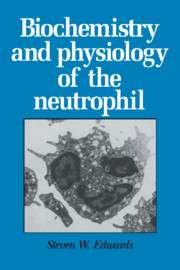Book contents
- Frontmatter
- Contents
- Abbreviations
- Preface
- 1 Neutrophils and host defence: The fight against infection
- 2 The development and structure of mature neutrophils
- 3 The generation and recognition of neutrophil-activating factors: Structure and function of neutrophil receptors
- 4 The cytoskeleton: The molecular framework regulating cell shape and the traffic of intracellular components
- 5 The respiratory burst: The generation of reactive oxygen metabolites and their role in microbial killing
- 6 Neutrophil activation: The production of intracellular signalling molecules
- 7 Neutrophil priming: Regulation of neutrophil function during inflammatory activation
- 8 Disorders of neutrophil function
- Index
1 - Neutrophils and host defence: The fight against infection
Published online by Cambridge University Press: 26 February 2010
- Frontmatter
- Contents
- Abbreviations
- Preface
- 1 Neutrophils and host defence: The fight against infection
- 2 The development and structure of mature neutrophils
- 3 The generation and recognition of neutrophil-activating factors: Structure and function of neutrophil receptors
- 4 The cytoskeleton: The molecular framework regulating cell shape and the traffic of intracellular components
- 5 The respiratory burst: The generation of reactive oxygen metabolites and their role in microbial killing
- 6 Neutrophil activation: The production of intracellular signalling molecules
- 7 Neutrophil priming: Regulation of neutrophil function during inflammatory activation
- 8 Disorders of neutrophil function
- Index
Summary
The neutrophil, the subject of this book, plays a key role as part of the immune response to microbial infections. Its major function is the rapid killing of bacteria and fungi before they multiply and spread throughout the body. The neutrophil is only one arm of the immune system, which includes other leukocytes, lymphocytes and molecular components such as complement, antibodies, acute phase proteins and cytokines. These cellular and molecular components of immunity constitute a co-ordinated and sophisticated network that has evolved in order to maximise the survival of the host against the range of pathogens it encounters daily. This chapter describes the role of the neutrophil within this immune network. Other elements of the immune system (the cellular and molecular components) are also briefly described but only with emphasis on how they interact with neutrophil function; thus, the descriptions of these systems focus upon how the cellular and molecular elements assist neutrophil function during infection and how neutrophils themselves may affect and regulate other aspects of the immune response. A more complete description of the immune system may be found in texts such as Davey (1989), Roitt (1990) and Benjamini and Leskowitz (1991).
The immune system
The immune system protects humans and animals from microbial infections by such infectious agents as bacteria, yeasts and fungi, viruses and protozoa. These differ greatly not only in their size but in their structural and molecular properties, as well as in the ways in which they seek to infect our bodies. Some of these pathogens infect bodily fluids, some penetrate tissues and some even survive and multiply within individual host cells.
- Type
- Chapter
- Information
- Biochemistry and Physiology of the Neutrophil , pp. 1 - 32Publisher: Cambridge University PressPrint publication year: 1994
- 1
- Cited by



